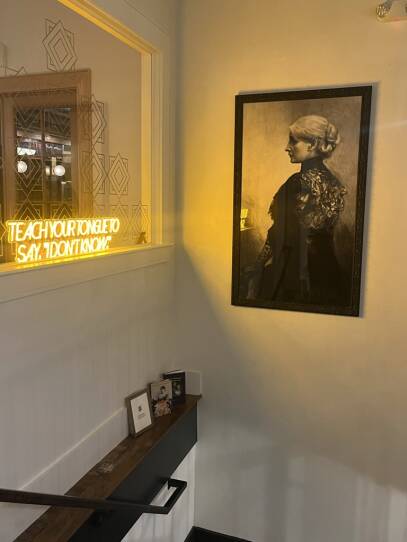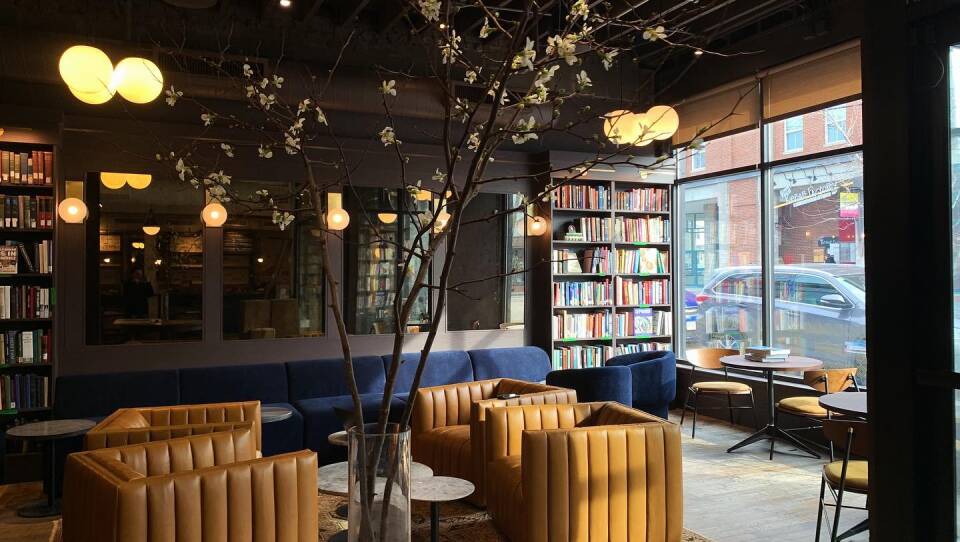"Lehrhaus" means "house of learning" in German, and a newly opened restaurant in Somerville bearing that name is just that. Founded by Rabbi Charlie Schwartz and journalist and Atlas Obscura co-founder Joshua Foer, they describe Lehrhaus as a fusion of two distinctly Jewish traditions: the tavern and the beit midrash, or study hall.
During the 19th century in Eastern Europe, as antisemitism excluded Jews from numerous sectors of professional life, many became tavern owners. These taverns doubled as places where people could gather and discuss the goings on in their communities. In the same spirit, the millennia-old beit midrash, Foer says, "Is the place where Jews would gather to discuss their texts and tradition and debate and argue and engage with ideas." Together, he and Schwartz have married these institutions, "mashing them up and putting them together in one space."
“We're at a time in America right now where a lot of people in the Jewish community are feeling like it might be a time to retreat from public spaces and retreat from identity in some key ways,” says Schwartz. “We want to continue to like to show the best parts of the Jewish community in the world, and we're not going anywhere. And we need to be part of the hard conversations that are out there.”
According to a new report from the Anti-Defamation League, there were an unprecedented 3,697 recorded incidents of antisemitic assaults across the United States last year, with Massachusetts ranking sixth in the nation in the number of such acts. In opposition to overt and public acts of antisemitism, Lehrhaus is not only a Jewish gathering place, but one where all are welcome to learn about Jewish culture and tradition.
More Music & Culture
Schwartz explains why these two places should live together: “The seat of Western knowledge is the library, and the sound of a library of silence. The seat of Jewish knowledge is the house of learning — the beit midrash — and the sound of a beit midrash is actually really loud because people are arguing and disagreeing and discussing things. Which is actually more similar to a bar or tavern."
The restaurant staff include seven-time James Beard Award nominee Michael Leviton as advising chef; Noah Clickstein, of Union Square's Juliet and the now-shuttered L’Espalier, as the executive chef; and Naomi Levy, who created the Hanukkah Pop-up Maccabee Bar and Ski Bar in Bow Market, as head of the drink program. The pages of the menu have been designed to look like pages from the Talmud, the marginalia containing commentary and history on the available dishes.
The food itself is kosher, and the only flesh you'll find is that belonging to the fishes. It's also intended to broaden a gentile's understanding of what Jewish food is — Schwartz jokes about an ongoing debate in the restaurant concerning the point at which kugel becomes macaroni and cheese. Other items like the Old Bay fish and chips attempt to reclaim the Jewish heritage of familiar dishes. Fried fish was introduced to the United Kingdom via Sephardic Jews expelled from Spain; Old Bay was created by German-Jewish spice merchant Gustav Brunn, who escaped Buchenwald concentration camp before settling in Baltimore and creating the beloved blend.

The menu also aims to expand gentiles' knowledge of Jewish food by showcasing an array of flavors from the diaspora.
"A lot of people know deli and a lot of people know what Israeli flavors are," notes Schwartz. "But there's a whole host of Jewish foodways outside of those realms that we're looking to highlight."
Befitting the nature of Lehrhaus, such observations prompt a culinary and philosophical debate: what makes Jewish food Jewish? Executive chef Noah Clickstein argues that there are three components that make it so. His favorite of those components is tradition.
"I think of the song in 'Fiddler on the Roof' — this is just food that's been done this way for hundreds and thousands of years," Clickstein says. "There are things that have to do with the way we consume food over the holidays." His example? Hamantaschen, triangular cookies with a variety of fillings, traditionally eaten at Purim.
Clickstein says time and constraint are the other two components of Jewish cooking. While bound together, they are still distinct. Time, he says, is what unites Jewish people around the world, because it is the time of Shabbat. When you can't labor in the kitchen for a full day, necessity dictates you get creative with how you prepare food.
"You almost have to plan this food to be cooked the next day while still being warm," he explains. "So you get a lot of stews and breads that would be put in an oven where the coals just stay warm and help heat them throughout. And I think it's really fun to be able to see that unifying long, slow, cooking time in a lot of the foods that I've seen."
On the other hand, constraint is directed by the laws of Kashrut. In a simple situation, the primary concern would be whether or not an item or meal is kosher. But running a restaurant brings another level of constraints that require a different kind of hustle.
"As a restaurant, sourcing products has been rather difficult," says the chef. "Finding quality kosher ingredients that the distributors that I'm used to working with will be able to bring in here has created a lot of constraints that breed creativity. There's a lot of niche ingredients that represents people that are not in the Boston area, and that has been hard to find." Of note: Norweigian-style schmaltz herring, and Ethiopian spices like besobela (like basil) and korerima (black cardamom) from Ethiopia.

"So many American Jews trace their heritage back to Eastern Europe, but that's only a small piece of the Jewish story," added Foer. The challenge, he says, "lies in creating a space that brings all of those flavors together and starts to remix them in interesting ways." Meeting the challenge unlocks a global cuisine: a red lentil stew from the Beta Israel community in Ethiopia, a vegetarian chopped "liver" relying on cashews and eggplant, the bites from Jewish gauchos in Argentina, a pickled mango chutney born of contact between Jews in India and Iraq.
Levy's cocktails showcase a similar geographic diversity. The hawaij espresso martini relies on a spice blend from Yemenite Jews, and the margarita thrusts a spicy Iraqi zhug into the spotlight.
“We’re really purposeful in our move away from that Ashkenazi-normative kind of thing that you see at a lot of Jewish spaces in the United States,” she said. “I really loved, as someone who is Ashkenazi, to be able to open up my world a little bit as well and learn more about how different Jewish cultures around the world celebrate and eat.”
The rules of the bar are different from those in the kitchen, but those constraints still present their own challenges — and Levy has gotten creative in meeting them. She explained that, since not all categories of spirits are required to carry a hechsher (the printed seal signifying a product as kosher), it can be difficult to find ones that meet the requirements of kashrut. And if you narrow down to the ones that do, the options may be incredibly limited.
Consider the banana liqueur used in the tavern's tropically inspired cocktail rooted in Ethiopian ingredients. The liqueur is literally hers —Levy’s preferred brand isn’t kosher, so she decided to just make her own.
But it’s an amari-centric journey that encapsulates the challenge of building this drink program. The family of herbal liqueurs features a range of flavor profiles, but many of them aren’t actually kosher — and the ones that are, Levy found, typically fall into the bitter group of fernets. However, the search for usable amari led her to West Coast distillery Brovo, and the important discovery that — although the bottles didn’t carry a hechsher— the process seemed to yield an otherwise kosher product. “We wound up sending a rabbi out there to check out the facilities, and got them approved by our kosher certification company for us to use on our bar,” she explained. (A bonus outcome: because the ingredients Brovo was using were already certified kosher, the company decided to get its certification.)
Schwartz will quickly dispel any notion that a restaurant featuring Jewish cuisine is inherently unusual or inaccessible. He and Foer want anyone to feel free to be curious and sit for a meal. As Schwartz reasons, "I'm not Irish, I go to Irish pubs, and I really enjoy that experience. But I know an Irish person might experience it differently. In the same way, you don't have to be Jewish to come to a Jewish tavern, right?”
Food is a major focus here, but it’s important to remember the establishment is also one for nourishing the mind.
Floating above stairs leading to the restaurant’s offices and kitchens is a large portrait of a woman in profile, Bertha Pappenheim. During the interwar years in Frankfurt, Germany, she could be found at philosopher Franz Rosenzweig's Lehrhaus, lecturing and leading discussions about the value of social work. She was a towering figure of German-Jewish feminism, and was honored with a postage stamp issued by the West German government in 1954. As one in the ranks of the dead, Pappenheim, absent a corporeal form, exists everywhere and nowhere: in books she wrote and books about her, on that postage stamp, and gracing the stairs of Lehrhaus.
"She is an incredible woman who should be in the upper echelon of the pantheon of Jewish heroes, and nobody knows about her," explains Foer. "She was the founder of, essentially, German feminism. She traveled all over Eastern Europe crusading for social justice. She was Orthodox, and a Torah scholar. And so we're trying to resuscitate her reputation and make her into kind of an icon of this space. It's the one thing in here that really takes you back to 1920s Frankfurt and the original Lehrhaus."

Foer explains that Rosenzweig, with his interwar institution, was "trying to reinvent Judaism from the outside in." His Lehrhaus was a generative space that welcomed religious and secular intellectuals to debate Jewish topics. The resulting interactions had a profound impact on Judaism throughout the diaspora. And that's the guiding spirit of this Somerville space.
"We want this Lehrhaus to be a continuation of that and to bring together different flavors, different kinds of ideas, different kinds of people in a generative way," says Foer.
One of the first things you notice upon entering is the abundance of texts on the wall (about 3,000, by Schwartz's estimation): cookbooks and graphic novels by Jewish authors; dozens of Talmudic volumes; the memoirs of 17th-century business woman Glückel of Hameln; and "Yabia Omer," a collection of legal rulings by Ovadia Yosef, Israel's Sephardic chief rabbi from 1973 and 1983.
Unlike some restaurants and bars that stock up on weathered books, with their yellowed pages and cracked leather spines, the founders of Lehrhaus fully expect patrons to engage with those placed throughout the restaurant. Ditto what Foer calls their curated collection of "magical Jewish objects": a print of Andy Warhol's portrait of Martin Buber, a vintage television set playing a clips from the 1937 Yiddish-language film "The Dybbuk," a vinyl copy of Moroccan singer Zohra Al Fassiya's "Kassidat Sidi Mohammed El Khamis" ("A deep Jewish music cut," says Schwartz.) Visually, Lehrhaus leans heavy into a recurring motif — an abstracted Star of David that's reminiscent of Second Temple tile work, designed with Boston branding agency Proverb, can be found throughout the establishment.
Lehrhaus is a peak example of building the thing you want to see in the world; this space holds special significance to Schwartz and Foer’s younger selves.
“In my early twenties, I don't think there were any Jewish spaces that I would have felt proud going to,” says Schwartz. “I think having a place — where whether it's the food or the aesthetics or the learning — where the best parts of Judaism are put forward in a very public way, would've been an incredibly powerful experience for me and for in my own identity.”
"When I was in my twenties, it started to dawn on me that I might be incredibly literate about a whole bunch of subjects, but I actually was pretty illiterate in my own Jewish textual tradition," Foer reveals. "And here you have 3,000 years of the greatest minds of the Jewish people arguing back and forth with each other across centuries, across continents, across languages. And it's not actually a bunch of books on the shelf. It is a bunch of spaces like this that happened to be captured in books that are now on a shelf. And it's an ongoing conversation. This realization that I can be a part of that was an incredible revelation. I'm excited to have a space where that can be shared with other people."
Lehrhaus is open Monday-Thursday 4:30 pm-10:00 pm, and Sundays 4:30 pm-9:00 pm. It's currently in its soft-opening phase, accommodating groups of six or smaller. Its grand opening, when it will be operating at full capacity, is on April 17th.









